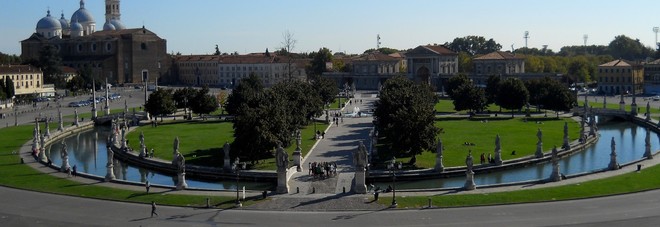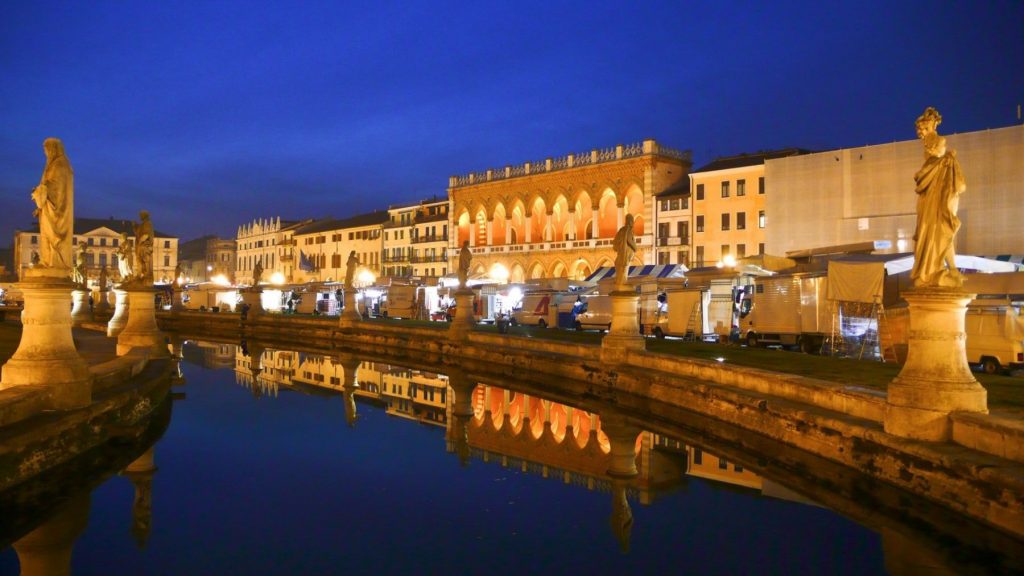There are places we cannot part from because their timeless charm is deeply etched in our souls. One of them is undoubtedly Prato della Valle (Lawn of the Valley), the beating heart of my town, Padua. It is a majestic square that holds the ancient history of Roman Patavium. It’s an evocative, magical place with spectacular glimpses of rare beauty, where light offers a surprising and moving experience. In the midst of the morning fog, you could be overwhelmed by the pearl-colored Isola Memmia (Isle Memmia), a view that can sometimes be surreal and fantastic, almost like a painting. Whereas in spring and summer the sun-drenched square bustles with people and conveys pure delight. The surface of the Canaletta (Little Channel) shines with an endless range of colors, whereas the shapes of trees are clearly outlined against the blue sky.

Actually, Prato della Valle (or as we call it, just “the Prato”) is not simply a place, but a state of mind through which everyone can freely rediscover his own true nature. If you want to grasp its real essence, just let yourself go. You can stroll around the square admiring this huge area in amazement, check out its sumptuous historical mansions, sit on the benches and enjoy an ice cream, rent a bicycle, or taste our popular “spritz” at one of our many outdoor cafés. You could also admire the perfect harmony created by the double ring of statues in their elliptical shape, and learn more about the prominent citizens portrayed. Most of them were born in Padua, others became adoptive citizens; however, all of them made our town renowned.
I think this is the secret behind its charm. The Prato is full of art, history, and traditions. It is also known as “Il Prato senza erba” (The lawn without grass). In fact, according to chronicles in the nineteenth century, a hundred trees were planted, which for a long time, made it impossible for grass to grow. It is only a few minutes’ walk from Saint Anthony Basilica. Thanks to a surface of 88.620 m2, it is considered the biggest square in Europe.
 Its unusual name dates back to the Medieval Age. In fact, at that time the Latin word Pratum meant a wide area devoted to trading purposes, which, if not paved, could also be covered with grass. Whereas the word Valle (Valley) i.e. ‘marshy place’, referred to the quaggy land where still water created some sort of basin or valley. However, that area already existed before the Middle Ages. The present square was a Roman circus for horse races and a theatre during the first century b.C. in the ancient city of Patavium. The theatre stood until the eleventh century and later it was used as a pit. In fact, some of the stones were used to build Rialto Bridge in Venice. At that time it was called Campo Marzio, due to the military briefings occurring there.
Its unusual name dates back to the Medieval Age. In fact, at that time the Latin word Pratum meant a wide area devoted to trading purposes, which, if not paved, could also be covered with grass. Whereas the word Valle (Valley) i.e. ‘marshy place’, referred to the quaggy land where still water created some sort of basin or valley. However, that area already existed before the Middle Ages. The present square was a Roman circus for horse races and a theatre during the first century b.C. in the ancient city of Patavium. The theatre stood until the eleventh century and later it was used as a pit. In fact, some of the stones were used to build Rialto Bridge in Venice. At that time it was called Campo Marzio, due to the military briefings occurring there.
Certainly, the Roman origin of Padua also played a key role in the following centuries. The value of this legacy was celebrated in 2017 on the two thousandth anniversary of Titus Livius’ death (a famous Paduan historian). The Municipality, in cooperation with the University of Padua and the Heritage Department, gave the green light to the excavations of the ancient Roman theatre. It was an ambitious project aimed at draining the Canaletta located along the Isola Memmia and studying the artifacts that were found after bringing the cavea (enclosure) to light. Up until December 2017, archaeology lovers could admire the site through scheduled guided tours which were really successful.
Going back to our historical outline, it should also be emphasized that after the Roman Age, this area went through numerous transformations. During Christian persecution, the circus was used for battles and two of the four patrons of Padua were martyrized here including, Saint Justine (for whom the homonymous Basilica is named) and Saint Daniel. Later on, it was called “Valley of the Market” and also “Lawn of Saint Justin”.
Whereas in the Middle Ages the square held jousts, public holidays and fairs. Among them, two were worth noting: the races of sedioli (a Paduan two-horsed chariot) and the “castle of love” where young men attempted to conquer the hearts of maidens who were locked up in a tower.

But it was in the eighteenth century that this square underwent great changes. The idea came from Andrea Memmo, a high-ranking official of the Venetian Republic who was also fond of architecture. He arrived in Padua in 1775 and ordered the reclamation of the entire area that until then, was basically a swamp. The project was assigned to Domenico Cerato, abbot and Professor of Architecture at the University of Padua. The works started in summer 1775, in preparation for the autumn fair dedicated to Saint Justin. The new look of the Prato would feature a central isle (named Isola Memmia after its creator) surrounded by an artificial elliptical channel displaying a double ring of statues, in total 78 (the original project envisioned 88 of them). Among the most eminent people portrayed was Andrea Memmo himself, but also Antenore, the mythical founder of Padua in 1132 b.C., Titus Livius, Petrarca, Tasso, Ariosto, Mantegna, and Galileo.
It still looks this way today after over two centuries, and we can still admire it in all its splendor. In fact, it is the meeting point for skaters and joggers, but its breathtaking beauty also makes it the favorite place of musicians, lovers cuddling along the Canaletta, families with children, and the hundred thousand tourists who have always been enchanted by it.
The local market with more than a hundred and sixty stands takes place on Saturdays welcoming plenty of visitors. The most renowned event undoubtedly occurs on 13th June, the Fair of Saint Anthony, which celebrates the saint’s death which took place in Padua in 1231 a.D. For this occasion, thousands of pilgrims arrive in town in order to pay homage to him, as well as to attend the procession in his honor.
The square typically hosts numerous events throughout the year ranging from Italian and European food and wine shows to sporting events to prestigious concerts. Two other major events are New Year’s Eve and the 15th of August (National Holiday called “Ferragosto”) when a joyful crowd meets for a firework show that explodes in a whirlwind of colors and unforgettable emotions.
Of course, its charm also inspired artists, travelers, and writers. Among them, Canaletto and Francesco Piranesi. Gabriele D’Annunzio praised its beauty by dedicating a sonnet to his “City of Silence” and composed some lines which are carved on a memorial stone under the portico of Loggia Amulea.
The Prato is a treasure to discover but, if you wish to fully understand it, you really must come and experience it for yourself.
Article by: Cristina Zuccato
Photo copyrights: ilgazzettino.it, padovacultura.padovanet.it, pratodellavalle.it

